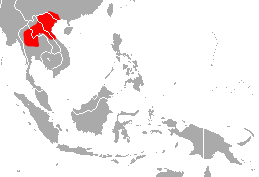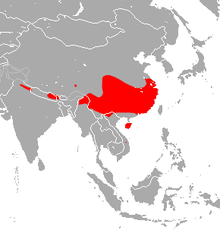
Severe acute respiratory syndrome–related coronavirus is a species of virus consisting of many known strains phylogenetically related to severe acute respiratory syndrome coronavirus 1 (SARS-CoV-1) that have been shown to possess the capability to infect humans, bats, and certain other mammals. These enveloped, positive-sense single-stranded RNA viruses enter host cells by binding to the angiotensin-converting enzyme 2 (ACE2) receptor. The SARSr-CoV species is a member of the genus Betacoronavirus and of the subgenus Sarbecovirus.

Horseshoe bats are bats in the family Rhinolophidae. In addition to the single living genus, Rhinolophus, which has about 106 species, the extinct genus Palaeonycteris has been recognized. Horseshoe bats are closely related to the Old World leaf-nosed bats, family Hipposideridae, which have sometimes been included in Rhinolophidae. The horseshoe bats are divided into six subgenera and many species groups. The most recent common ancestor of all horseshoe bats lived 34–40 million years ago, though it is unclear where the geographic roots of the family are, and attempts to determine its biogeography have been indecisive. Their taxonomy is complex, as genetic evidence shows the likely existence of many cryptic species, as well as species recognized as distinct that may have little genetic divergence from previously recognized taxa. They are found in the Old World, mostly in tropical or subtropical areas, including Africa, Asia, Europe, and Oceania.

Severe acute respiratory syndrome coronavirus 1 is a strain of coronavirus that causes severe acute respiratory syndrome (SARS), the respiratory illness responsible for the 2002–2004 SARS outbreak. It is an enveloped, positive-sense, single-stranded RNA virus which infects the epithelial cells within the lungs. The virus enters the host cell by binding to angiotensin-converting enzyme 2. It infects humans, bats, and palm civets.

The great roundleaf bat, also known as the great Himalayan leaf-nosed bat is a species of bat in the family Hipposideridae found in South Asia, Southeast Asia, and China. It gives birth to two young a year. It has been assessed as least concern by the IUCN.

Bourret's horseshoe bat is a species of horseshoe bat native to Southeast Asia. The name "paradoxolophus" is derived from the Greek words paradoxos, meaning "contrary to expectation", and lophos, meaning "crest". This name refers to the bat's difference in nose-leaf morphology compared to other Rhinolophus species. There are no recognised subspecies.

Pearson's horseshoe bat is a species of bat in the family Rhinolophidae. It is found in Bangladesh, Bhutan, China, India, Laos, Malaysia, Myanmar, Nepal, Thailand and Vietnam.

The least horseshoe bat is a species of bat in the family Rhinolophidae. It is found in Cambodia, China, India, Indonesia, Laos, Malaysia, Myanmar, Nepal, Thailand and Vietnam. It is a food source of the parasite Sinospelaeobdella, a jawed land leech.

Jinning District is one of seven districts of the prefecture-level city of Kunming, the capital of Yunnan Province, Southwest China. The formation of the district was approved on November 24, 2016, after the dissolution of the former Jinning County (晋宁县) by the State Council. It is located at the southern tip of Dian Lake and is well known within China as the birthplace of Zheng He.
Bat SARS-like coronavirus WIV1, also sometimes called SARS-like coronavirus WIV1, is a strain of severe acute respiratory syndrome–related coronavirus (SARSr-CoV) isolated from Chinese rufous horseshoe bats in 2013. Like all coronaviruses, virions consist of single-stranded positive-sense RNA enclosed within an envelope.

The bat virome is the group of viruses associated with bats. Bats host a diverse array of viruses, including all seven types described by the Baltimore classification system: (I) double-stranded DNA viruses; (II) single-stranded DNA viruses; (III) double-stranded RNA viruses; (IV) positive-sense single-stranded RNA viruses; (V) negative-sense single-stranded RNA viruses; (VI) positive-sense single-stranded RNA viruses that replicate through a DNA intermediate; and (VII) double-stranded DNA viruses that replicate through a single-stranded RNA intermediate. The greatest share of bat-associated viruses identified as of 2020 are of type IV, in the family Coronaviridae.
Shi Zhengli is a Chinese virologist who researches SARS-like coronaviruses of bat origin. Shi directs the Center for Emerging Infectious Diseases at the Wuhan Institute of Virology (WIV). In 2017, Shi and her colleague Cui Jie discovered that the SARS coronavirus likely originated in a population of cave-dwelling horseshoe bats in Xiyang Yi Ethnic Township, Yunnan. She came to prominence in the popular press as "Batwoman" during the COVID-19 pandemic for her work with bat coronaviruses. Shi was included in Time's 100 Most Influential People of 2020.
SHC014-CoV is a SARS-like coronavirus (SL-COV) which infects horseshoe bats. It was discovered in Kunming in Yunnan Province, China. It was discovered along with SL-CoV Rs3367, which was the first bat SARS-like coronavirus shown to directly infect a human cell line. The line of Rs3367 that infected human cells was named Bat SARS-like coronavirus WIV1.
Bat coronavirus RaTG13 is a SARS-like betacoronavirus that infects the horseshoe bat Rhinolophus affinis. It was discovered in 2013 in bat droppings from a mining cave near the town of Tongguan in Mojiang county in Yunnan, China. In February 2020, it was identified as the closest known relative of SARS-CoV-2, the virus that causes COVID-19, sharing 96.1% nucleotide similarity. However, in 2022, scientists found three closer matches in bats found 530 km south, in Feuang, Laos, designated as BANAL-52, BANAL-103 and BANAL-236.
Sinospelaeobdella is a genus of jawed land leech, endemic to caves in China. It contains the species S. cavatuses and S. wulingensis, the latter being named after the Wuling Mountains where it was found.
Rc-o319 is a bat-derived strain of severe acute respiratory syndrome–related coronavirus collected in Little Japanese horseshoe bats from sites in Iwate, Japan. Its has 81% similarity to SARS-CoV-2 and is the earliest strain branch of the SARS-CoV-2 related coronavirus.
Civet SARS-CoV is a coronavirus associated with Severe acute respiratory syndrome coronavirus (SARS-CoV), which infected humans and caused SARS events from 2002 to 2003. It infected the masked palm civet. The severe acute respiratory syndrome coronavirus (SARS-CoV) is highly similar, with a genome sequence similarity of about 99.8%. Because several patients infected at the early stage of the epidemic had contact with fruit-eating Japanese Raccoon Dog in the market, fruit-eating Tanuki may be a direct source of human SARS coronavirus. At the end of 2003, four more people in Guangzhou, China were infected with the disease. Sequence analysis found that the similarity with the Tanuki virus reached 99.9%, and the SARS coronavirus was also caused by cases of Tanuki transmission.
Bat coronavirus RpYN06 is a SARS-like betacoronavirus that infects the horseshoe bat Rhinolophus pusillus, it is a close relative of SARS-CoV-2 with a 94.48% sequence identity.
16BO133 is a SARS-like coronavirus (SL-COV) which was found in the greater horseshoe bat in South Korea. It was published in 2019 and its genome was completely sequenced. The sequenced Korean SARSr-CoV strain belongs to the severe acute respiratory syndrome coronavirus 1, and its genome sequence similarity is 82.8%.
LYRa11 is a SARS-like coronavirus (SL-COV) which was identified in 2011 in samples of intermediate horseshoe bats in Baoshan, Yunnan, China. The genome of this virus strain is 29805nt long, and the similarity to the whole genome sequence of SARS-CoV that caused the SARS outbreak is 91%. It was published in 2014. Like SARS-CoV and SARS-CoV-2, LYRa11 virus uses ACE2 as a receptor for infecting cells.
ZC45 and ZXC21, sometimes known as the Zhoushan virus, are two bat-derived strains of severe acute respiratory syndrome–related coronavirus. They were collected from least horseshoe bats by personnel from military laboratories in the Third Military Medical University and the Research Institute for Medicine of Nanjing Command between July 2015 and February 2017 from sites in Zhoushan, Zhejiang, China, and published in 2018. These two virus strains belong to the clade of SARS-CoV-2, the virus strain that causes COVID-19, sharing 88% nucleotide identity at the scale of the complete virus genome.











